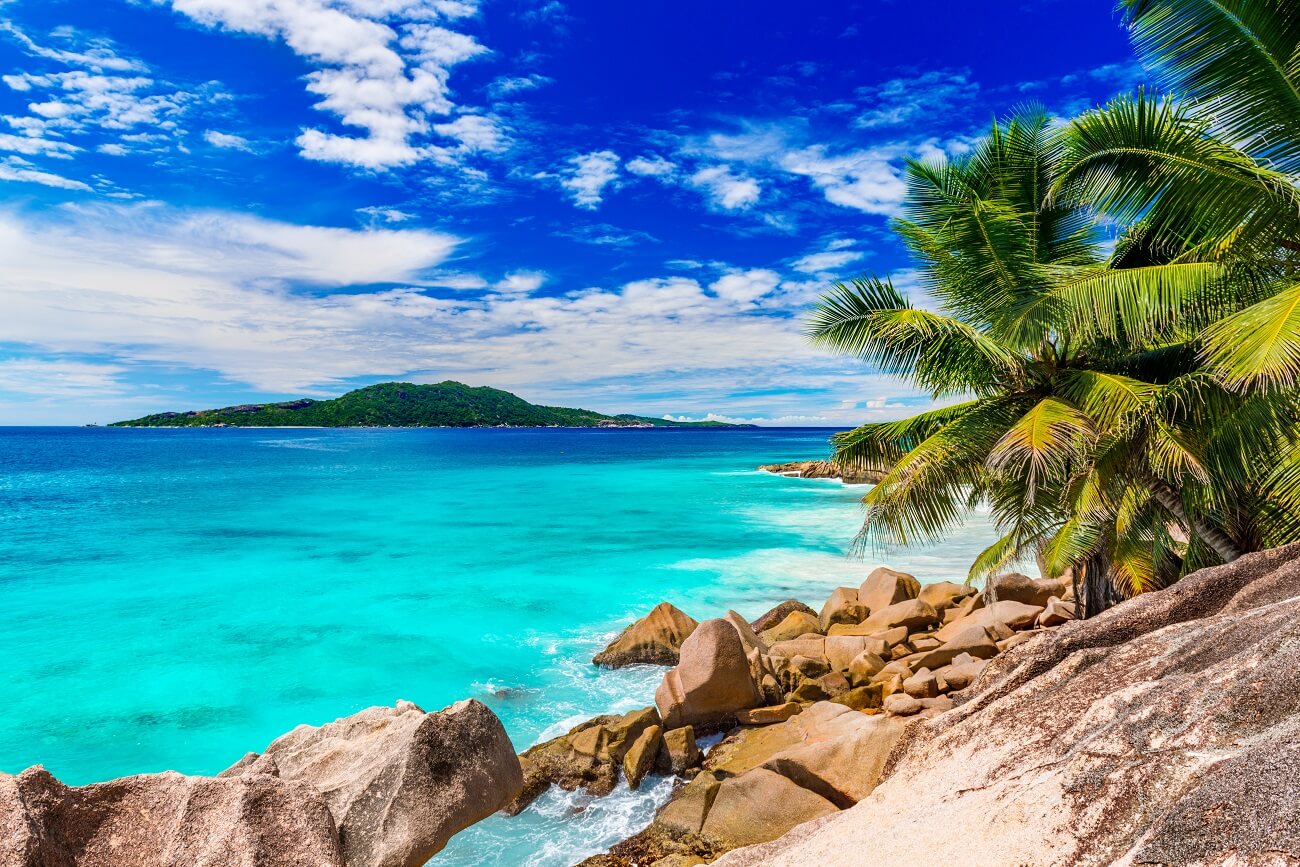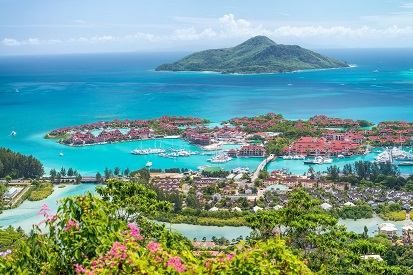

The Seychelles palm tree is famous for having the heaviest fruits in the world. Coco de Mer nuts have an awkward and intriguing shape, reminiscent of a woman's buttocks. For this they have become the “business card” of the Seychelles. And the cost of a rare fruit is at least several hundred dollars!
The Seychelles is the only place on Earth where this amazing coconut grows. It is so rare and expensive that poachers hunt for it, and the Seychelles palm tree is protected in every possible way at the state level.
The fruits of the Coco de Mer palm tree have become a symbol of Seychelles. Their image can even be seen on the stamp in the international passport, which is placed upon arrival.
Coco de mer is a dioecious palm. This means that some trees bear male flowers, while others bear female flowers. It was the female fruits, which can weigh more than 30 kg and reach half a meter in length, that became the rare treasure that was hunted.
Shrouded in folklore and legend, the palm grows on only two of the 115 islands of the Seychelles - Praslin, the second largest island in the country after Mahe, and nearby Curieuse. Today, only about 8,000 mature trees exist. This plant is listed in the “red” book and is on the verge of extinction.

Depositphotos
Coco de Mer records
The heaviest recorded fruit weighed 43 kg, and the heaviest seeds in the world weighed 18 kg! The palm reaches a height of more than 40 meters, and the length of its leaves is about 10 meters. The giant tree grows to a mature age of 25-50 years! Once mature, palms begin to flower, producing seeds that take two years to germinate. Each tree can grow up to 70 nuts.
It takes another 7-10 years for the nut to grow and fall from the tree. Then it will take another 10 years before the fruits can be sent for sale. But the Coco de Mer palm is a long-lived palm tree, and can continue to produce flowers and fruit for up to 800 years.

Depositphotos
The history of the heaviest nuts in the world
For a long time, the origin of the giant fruits remained a mystery. They were found in the Indian Ocean, so there was a legend that the nuts grew on the seabed in the Divine Garden. In fact, coconut fruits were carried by the current, most often to the Maldives. If a nut falls into water, it sinks to the bottom due to its heavy weight. Due to the long stay under water, the husk falls off, the nut pulp decomposes, and gasses push the nut to the surface. The current picks up the fruit and carries it to other shores. Therefore, the Maldives have long been considered the birthplace of Coco de Mer. The amazing nuts were regarded exclusively as property of the king. And if anyone decided to hide the lucky find, his hands could easily be cut off for stealing royal property.

Depositphotos
Planting new coconut trees
Coco de Mer is endangered. Palm seeds are protected from poachers: they are sometimes even placed in a cage to protect them from theft.
Attempts are being made to grow new palm trees, but it is a slow process and not always successful. Recently, a program was developed to involve local residents in planting palm trees. Those interested are offered to plant up to five coconut seeds on their plot. The nuts for planting will come from the Vallée de Mai and the Fond-Ferdinand nature reserve, where about 50 fallen fruits are collected from the forest floor every month.
Since the palm tree grows at least 35 meters in height, it needs space: planting is available only to those who have a minimum free plot area of 10 square meters.
This program will help preserve coconuts as a cultural attraction without destroying their habitat.Unfortunately, since many years pass from planting a tree to producing fruit, not all tree owners will be able to see a coconut tree reach maturity in its lifetime.
Palm trees leave virtually no chance for other plants: they completely block out the light and absorb all the moisture. But new trees always grow next to the “mother”: heavy fruits cannot fly far, so giant trees grow in colonies.

Depositphotos
Legends of Coco de Mer
There are many myths about the unique palm tree and its fruits. The resemblance of male and female fruits to erotic forms gave rise to a legend: when there was a thunderstorm, late at night the trees would merge and make love. And those who see this process may go blind or even die.
According to another legend, the coconut in the Seychelles is the forbidden fruit that Eve gave to Adam in the Garden of Eden. It was the idea of British Major General Charles George Gordon, who landed in the Seychelles in 1881 and saw the unique erotic form of Coco de Mer.
For a long time there was an opinion that the coconut grows under water, and the sacred bird Garuda lives on its tree.
Local residents highly value the valuable properties of coconut and are confident that it has a healing effect. The fleshy coconut kernel is especially prized in East Asia, where it is believed to have aphrodisiac properties.

Depositphotos
How to buy coconut
Since 1978, the coconut trade has been controlled through a permit system. Anyone who grows a palm tree on their property or sells nuts must be registered with a special organization. The fruit can cost $300-600 depending on size and shape, which is why it is hunted by poachers.
Even coconut shells, which are sold to tourists for between $200 and $250, are sold with a permit. The proceeds from the sale of souvenirs are directed to environmental projects in Seychelles.
All coconut fruits in the Seychelles are numbered, so their quantity is easy to control. The collection of fruits is strictly controlled by the Ministry of the Environment. But there are still facts of coconut theft.

Depositphotos
Where can you buy fruits?
You can legally purchase a souvenir in the Valle de Mai nature reserve, where all coconuts have certificates.
On the island of Praslin, in the Vallée de Mai nature reserve, grows the largest colony of coconut trees in the world. There is also a souvenir shop selling palm fruits. In Anse Lazio there is a restaurant and bar called Bonbon Plume right on the beach where you can find coconuts.
Another place where you can buy them is the capital of the Seychelles, Victoria: check out the local market. The main thing is to make sure that all the papers are in order, there is an export license and there is a wet stamp. Otherwise you will not be able to leave the country. Moreover, according to local laws, you can be fined or even sent to prison. Also be sure to pay attention to the aesthetic disadvantages of coconut.

Depositphotos
Coco de Mer is a natural wonder and the pride of the Seychelles. Be sure to look at the tree during excursions and take a bright photo as a souvenir!
More articles
- Bali's Best Beach Clubs - 13 Luxury Oases
- Tips for tourists in Indonesia - how to avoid spoiled holidays
- Yoga Studios in Bali - where to catch Zen on the Island of the Gods
- Port Louis: All About Mauritius' Capital
- Seychelles Honeymoon Hotels: 9 Paradise Spots
- Bali's Best Eco-Hotels: Top 12 Spots
- Seychelles for outdoor activities - from diving to jungle trekking
- Why you can be deported from Bali - several main reasons
- Seychelles hotels with the best panoramic views
- UNESCO sites in Indonesia: temples, parks and other amazing places



